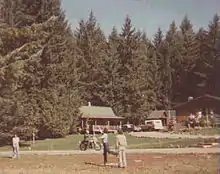Shiloh Youth Revival Centers
The Shiloh Youth Revival Centers movement was the largest Jesus People communal movement in the United States in the 1970s. Founded by John Higgins in 1968 as a small communal house – House of Miracles – in Costa Mesa, California, the movement quickly grew to a very large movement catering mostly to disaffected college-age youth. There were over 100,000 people involved and 175 communal houses established during its lifespan.

The notion of "being part of Shiloh" was not well-defined. Shiloh did not have official membership. The most generous definition of being "involved in Shiloh" ...in addition to the Staff ( offices. print shop. Land Staff. etc.) and the Teams (who were schooled and sent out to chosen cities to open a Shiloh House) would also include all the individuals who spent the night or days as guests. Shiloh houses operated like hippy-style rescue missions, in the sense that people who needed a place to stay for a couple nights were welcomed; but the guests were not documented; no identification was asked for; their names were not written down. Consequently, it is unclear how the claim of a hundred thousand people "involved in Shiloh" could be defended.[1]
Two years after the movement's founding, Higgins and some of the core members of the movement bought 90 acres (360,000 m2) of land near Dexter, Oregon, and built a new headquarters which they called "The Land". The movement grew quickly until the mid-1970s as growth in the Houses began to slow down. However, in the spring of 1978, some of the board members of Shiloh called for the resignation of the leader of the movement, John Higgins, alleging the improper use (their disagreement with the allocation of) the self-supporting earnings of the movement. Rather than fight the board's recommendations, Higgins quietly stepped down and the movement quickly dissolved.
Several individuals remained on the Oregon property as caretakers, but an eventual legal battle with the IRS over the charitable status of incomes earned by members during the movement's existence ultimately led to the complete dissolution and liquidation of the movement and its assets in 1989.
While membership in the movement was voluntary, it was also communal and required substantial commitment. To join the movement, members were expected to make a commitment to Jesus Christ and, in return, their needs would be provided for: food, clothing, shelter, and medical care. All members worked together for the support of the ministry, so all wages went into the common fund and were distributed throughout the Houses as needs were addressed.
See also
Lost Valley Educational Center is an intentional community ecovillage located on the old grounds of Shiloh in Dexter, Oregon. Areas of focus for the intentional community include personal growth, permaculture, sustainability, and simple living. There is no connection between Shiloh Youth Revival Centers and The Lost Valley Educational Center. They are two distinct organizations.
External links
References
- This edit was written by Jacob Wegelin, who lived in the communal Shiloh houses from July 1971 until August 1976, and edited again by Rhonda Gordon who lived in the communal houses from September 1972-July 1976 and then became part of the Shiloh Marrieds Ministry from July 1976 - September 1982.
- Goldman, M. S. Continuity in Collapse – Departures From Shiloh. Journal for the Scientific Study of Religion. 1995 Sep; 34(3):342–353.